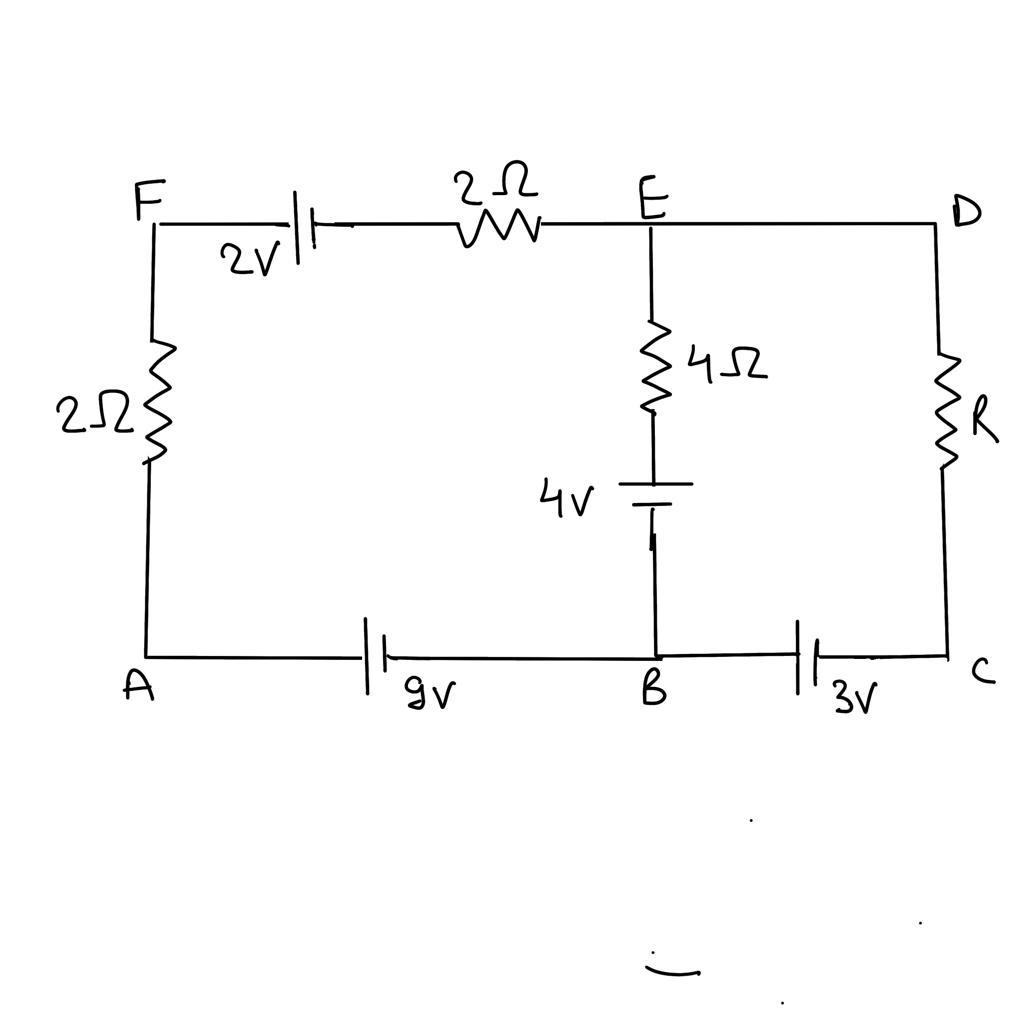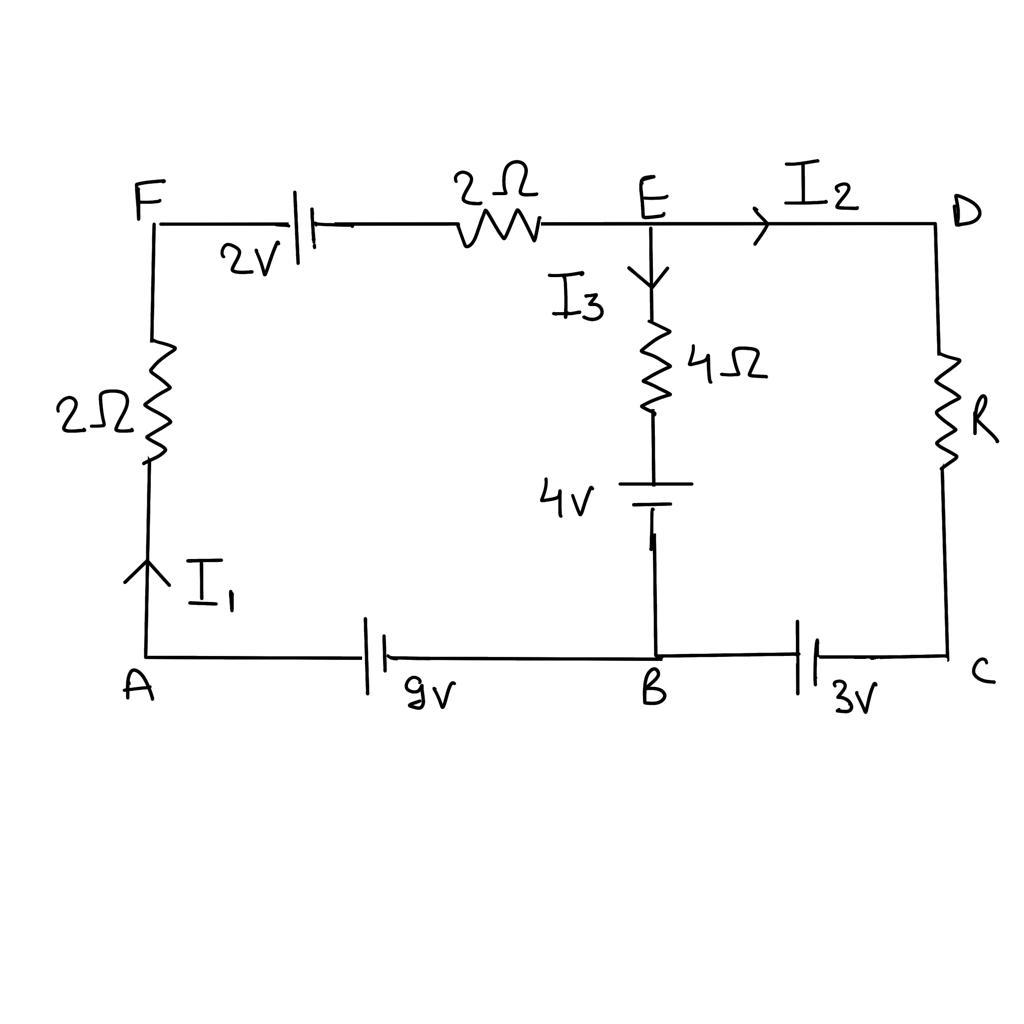
In the electric network shown, when no current flows through the 4$\Omega $ resistor in the arm EB the potential difference between the points A and D will be,

$A.$ 5V
$B.$ 3V
$C.$ 4V
$D.$ 6V

Answer
585.6k+ views
HINT- In series and parallel combination we have to keep in mind that current is same in series combination while the voltage is same in parallel combination. Potential difference is the difference in the amount of energy that charge carriers have between two points in a circuit. It is measured in volts (V) and is also called voltage.
Complete step-by-step answer:
Now from the question, we have
Let the potential of point B = 0
Therefore, the potential of point A and C will be 9V and 3V respectively.
Distributing current across the circuit as shown in figure and applying Kirchhoff law at junction E .

${I_1} = {I_3} + {I_2}$
As, ${I_3} = 0$ (since, there is no potential difference across EB)
Therefore, ${I_1} = {I_2}$
Also as ${I_3} = 0$
${V_E} = {V_B} + 4 = 4volts$
${V_E} = {V_D} = 4volts$
Therefore, potential difference between point A and D will be
= ${V_A} - {V_D}$
= (9-4) volts
= 5volts = 5V
Therefore, the correct option for the above question is option $A.$
NOTE- Kirchhoff’s laws
Kirchhoff’s circuit laws are two equalities that deal with the current and potential difference in the lumped electric model of electric circuits.
Kirchhoff’s current law- This is also called Kirchhoff’s first law, Kirchhoff’s point rule. This law states that, for any node (junction) in an electrical circuit, the sum of currents flowing into that node is equal to the sum of currents flowing out of that node; or equivalently. $\sum\limits_{k = 1}^n {{I_k}} = 0$, where n is the total number of branches with currents flowing towards or away from the node.
Kirchhoff’s voltage law- This law is also called Kirchhoff’s second law, Kirchhoff’s loop rule, and Kirchhoff’s second rule. This law states that the directed sum of the potential differences (voltages) around any closed loop is zero. $\sum\limits_{k = 1}^n {{V_k}} = 0$, here n is the total number of voltages measured.
Complete step-by-step answer:
Now from the question, we have
Let the potential of point B = 0
Therefore, the potential of point A and C will be 9V and 3V respectively.
Distributing current across the circuit as shown in figure and applying Kirchhoff law at junction E .

${I_1} = {I_3} + {I_2}$
As, ${I_3} = 0$ (since, there is no potential difference across EB)
Therefore, ${I_1} = {I_2}$
Also as ${I_3} = 0$
${V_E} = {V_B} + 4 = 4volts$
${V_E} = {V_D} = 4volts$
Therefore, potential difference between point A and D will be
= ${V_A} - {V_D}$
= (9-4) volts
= 5volts = 5V
Therefore, the correct option for the above question is option $A.$
NOTE- Kirchhoff’s laws
Kirchhoff’s circuit laws are two equalities that deal with the current and potential difference in the lumped electric model of electric circuits.
Kirchhoff’s current law- This is also called Kirchhoff’s first law, Kirchhoff’s point rule. This law states that, for any node (junction) in an electrical circuit, the sum of currents flowing into that node is equal to the sum of currents flowing out of that node; or equivalently. $\sum\limits_{k = 1}^n {{I_k}} = 0$, where n is the total number of branches with currents flowing towards or away from the node.
Kirchhoff’s voltage law- This law is also called Kirchhoff’s second law, Kirchhoff’s loop rule, and Kirchhoff’s second rule. This law states that the directed sum of the potential differences (voltages) around any closed loop is zero. $\sum\limits_{k = 1}^n {{V_k}} = 0$, here n is the total number of voltages measured.
Recently Updated Pages
Master Class 12 English: Engaging Questions & Answers for Success

Master Class 12 Economics: Engaging Questions & Answers for Success

Master Class 12 Social Science: Engaging Questions & Answers for Success

Master Class 12 Maths: Engaging Questions & Answers for Success

Master Class 12 Chemistry: Engaging Questions & Answers for Success

Master Class 12 Business Studies: Engaging Questions & Answers for Success

Trending doubts
What are the major means of transport Explain each class 12 social science CBSE

Which are the Top 10 Largest Countries of the World?

Draw a labelled sketch of the human eye class 12 physics CBSE

Explain sex determination in humans with line diag class 12 biology CBSE

The pH of the pancreatic juice is A 64 B 86 C 120 D class 12 biology CBSE

Explain sex determination in humans with the help of class 12 biology CBSE




